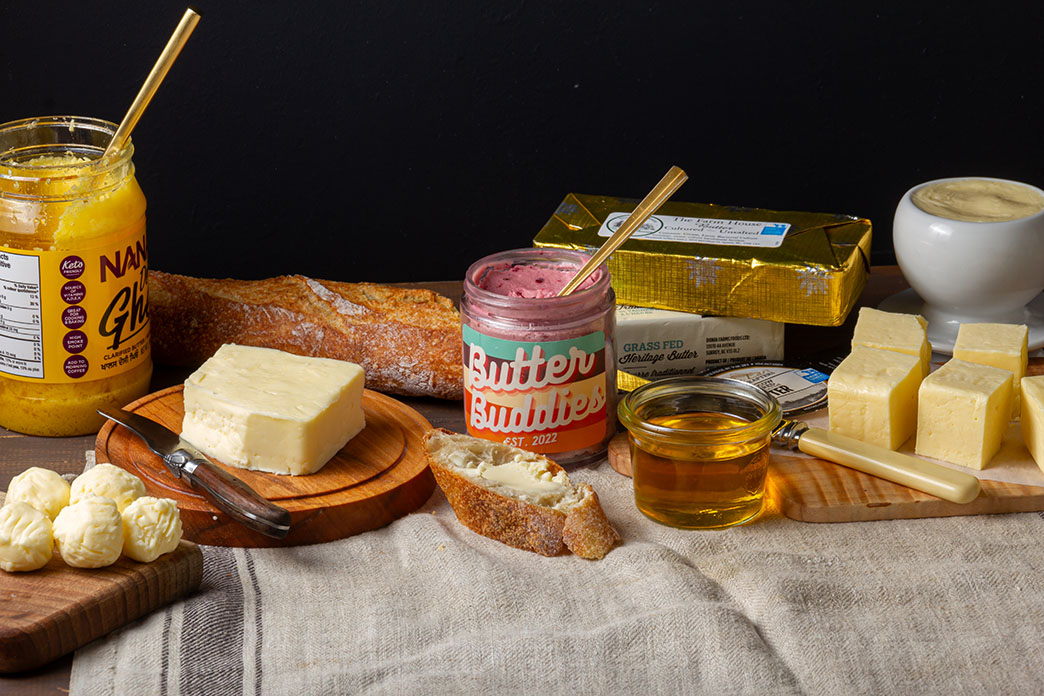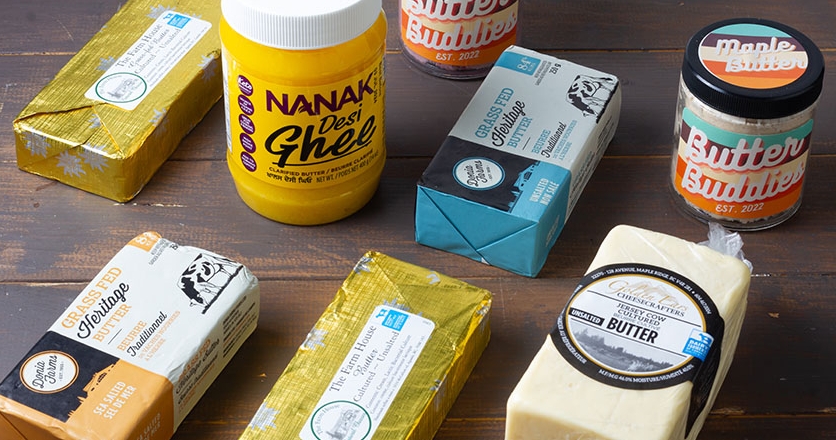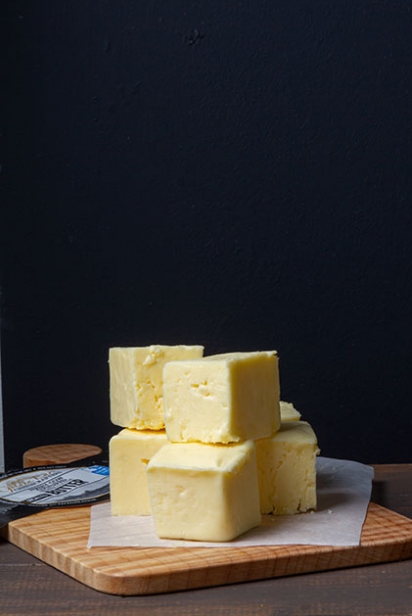Better Butter
Butter: Is there anything more heavenly or more versatile? Kept at room temperature on a plate, it spreads with perfect softness, adding salty richness to our morning toast. Cold, it forms pockets in pastry, fluffing it up and making it flaky. We cream it in cake, to make them rich and dense, or moist and tender. We use it to enrich sauces and make them glossy and silky smooth and we melt it on everything from shrimp to steak.
We eat it because it is delicious, not because it has nutrients, but we do hear that it contains Vitamins A, D, E. And when grass fed, even more so. The latter has higher concentrations of beneficial omega-3 fatty acids and CLAs (conjugated linoleic acids) and beneficial beta-carotene.
But back to the delicious part. The flavour part. The fat part. In Canada, butter must, by law, contain 80 per cent butterfat, an amount slightly lower than European butters, which are governed by similar regulations and which often contain 82 per cent fat. And while it wouldn’t seem that just two per cent would make a difference, this higher fat content is desirable for baking — it imparts richer flavour and improves texture. We are seeing higher-fat and grass-fed butters from across the country on our local shelves, but few come from right here in our own backyard.
Donia Farms in Surrey was founded in 1955 and has been run by the same family for three generations. David van Keulen oversees business operations for the family farm and, with his brothers Jonathan and Nico and their families, forms the newest generation to run the farm after their parents, Stan and Patricia, who ran it beginning in the 1990s. In 2016, the farm launched a direct-to-retail business to offer milk, cheese, yogurt and butter.
The van Keulens make their 84 per cent butterfat Grass Fed Heritage Butter with milk from the farm’s largely Holstein Friesian herd, which also contains a few Jerseys. The Friesians produce more milk, but the Jerseys produce a milk that’s higher in fat. They are also, says van Keulen, “a bit more mischievous,” compared to the laid-back Friesians. The cows are mostly grass fed — their feed consists of a mixture of 80 per cent grass and 20 per cent grains, which van Keulen says is important for the cows’ energy requirements.
What makes the butter special? It’s the unique diet we feed our cows,” van Keulen says, likening it to a wine’s terroir. The family is also keen to point out that cow comfort is something that doesn’t get talked about enough. If the cows are calm, he argues, they show it by producing more milk. To this end, the family houses its cows in free-stall barns, where they can move freely and have access to water and pasture as well as sandy beds in which to rest. Van Keulen also credits B.C.’s relatively temperate climate as being suitable for dairy production. The butter itself is manufactured out of province, using the farm’s cream, a decision that van Keulen explains is largely to do with finding the most suitable partner for the farm’s needs.
Butter as a byproduct
For artisanal cheesemakers in the Lower Mainland, butter production is a byproduct of cheesemaking. Emma Davison, who, with her sister Jenna, owns Golden Ears Cheesecrafters, explains that the winter season, when cows naturally produce higherfat milk, allows the company to make more butter. The cheese processor, based in Maple Ridge, makes butter with cream exclusively from Jersey cows. “Typically, Jersey milk fat content can be 4.5 to 4.8 per cent, whereas in the winter it can go up to 6 per cent or higher,” she explains.
Golden Ears’ much sought-after Jersey Cow Cultured Butter, which Davison says can have a fat content as high as 90 per cent, is a limited product uses an artisanal process whose production is totally governed by what cheese the sisters may be making. When they make fuller-fat cheeses such as Brie, they use more cream, so there is less available for butter. However, when they make a lower-fat cheese such as quark, they save the excess cream for butter. They make cultured butter by introducing live bacterial culture into the cream, which ripens it, enhancing its flavour and also acting as a preservative.
Because the cream is from grass-fed cows, Davison explains, the butter has high levels of carotene, giving it a deep yellow colour. She calls them “bricks of gold.” At the company’s farm shop, visitors can buy cheese and butter and also get a bit of insight as to how they're made, through the huge viewing window that looks into the cheese- and butter-making area.
“We wrap every brick by hand,” she says, which increases costs. But her customers don’t seem to mind. She gets requests from as far away as Quesnel.
Because exposure to air will keep the cultures in the butter developing, Davison recommends cutting the block into smaller pieces and freezing it, using small amounts at a time and allowing them to warm up at room temperature, as needed.
Gold standard
Butter at the Farmhouse Natural Cheeses in Agassiz is also a byproduct of cheesemaking. “The farm is within eyeshot of the plant,” Emily Bowen, plant manager, explains. Here the butter is made with milk from Brown Swiss, Guernsey and Jersey cows. The cows graze on pasture from March to November before coming inside, where they are fed more grass and some grains.
“We really value the roots of traditional butter-making, ” says Bowen, adding that the labour-intensive process is very “hands-on. ”
It is again, by its very nature, a limited product that can only be made in small batches despite being in great demand.
“We wrap our butter in gold foil because of how special it is, ” Bowen says.
All about ghee
On the shelves at Fruiticana, a South Asian grocery on Fraser Street, another butter product can be found, this one in more abundant quantities. One particular display, extending floor to ceiling, is filled with shelves of ghee, made by Surrey-based Nanak Foods. The quantity and sizes of the tubs, from 400 grams to three kilograms, is a testament to its prevalence in South Asian cuisine.
Ghee is made by removing the milk sugar, proteins and water from butter by gently heating it until what remains is 99.9 per cent milk fat. It’s similar to clarified butter but it has been cooked longer, so it has a richer nuttier flavour. It’s a staple of South Asian cooking, but is also increasingly popular among other cultures because of its versatility. With a smoke point of 485 F (250 C), ghee can be used to cook at much higher temperatures than butter, which starts to burn at just 350 F (175 C).
Nanak Foods produces desi ghee and a grass-fed version. Gurpreet Arneja, president of Nanak Foods, says, “Milk is an integral part of our cooking and confectionary.”
Arneja and CEO Vineet Taneja launched the company 26 years ago and began making paneer, a type of fresh cheese originating in South Asia. At that time, it was either made at home or only available through specialty South Asian shops from artisanal producers. The two saw the opportunity to make a product with longer shelf life that could be more readily available and serve more people. Today, they make a host of South Asian specialties including cheeses, desserts and confectionary items.
Arneja explains that Nanak’s process, which uses a traditional method of cooking the butter to separate the milk fat, allows it to acquire a nutty flavour. Th is differs from other similar products which may use mechanical separation of the various components.
Like butter, ghee contains Vitamin A, D and E and also contains benefi cial omega-3 fatty acids, but in higher concentrations. Because the lactose (milk sugar) and casein (milk protein) have been largely removed, it may be more tolerated by those with lactose intolerance, although it is not considered dairy free.
Butter with bonuses
While Nanak is removing elements from butter, others are adding things. Wyatt Sherman, founder of Butter Buddies, lays on the flavour in his line of jarred compound butters, which he launched in late 2022. Now making his products in Squamish, Sherman uses B.C. butter and flavours it with garlic and dill, or maple and cinnamon, as well as ingredients such as berries sourced from local farmers’ markets. He recommends using his Honey Chili Butter, made with Thai chilis, for glazing cooked vegetables or fi sh. The butters can also be used as a cup-for-cup substitute to add fl avour to a favourite cake recipe.
“You just get a creaminess with butter that you don’t get with oil,” Sherman, a chef who has worked in restaurants, resorts and mining exploration camps, explains. Serving compound butters flavoured with seasonal ingredients was one of his oft-used chef tricks. Many people enjoyed them, so he decided to make some to sell. While experienced chefs and bakers enjoy his butters, it’s less experienced cooks that can really benefi t from them by using them to pack flavour into their food. He adds, “I see it as a traditional whole food, a more natural alternative to processed oils.”
With so many options, it could be time to get baking again. Or maybe we just feel some toast coming on. On that note, pass the (local) butter, please.
Butter Buddies
butterbuddies.ca | @butterbuddiesca
Donia Farms
doniafarms.com | 778.773.5804 | @doniafarms
The Farm House Natural Cheeses
5634 McCallum Rd., Agassiz, B.C.
farmhousecheeses.com | @farmhousecheeses
Golden Ears Cheesecrafters
22270 128 Ave., Maple Ridge, B.C.
cheesecrafters.ca | 604.467.0004 | @goldenearscheesecrafters
Nanak Foods
nanakfoods.com | 604.594.9190 | @nanak_foods







